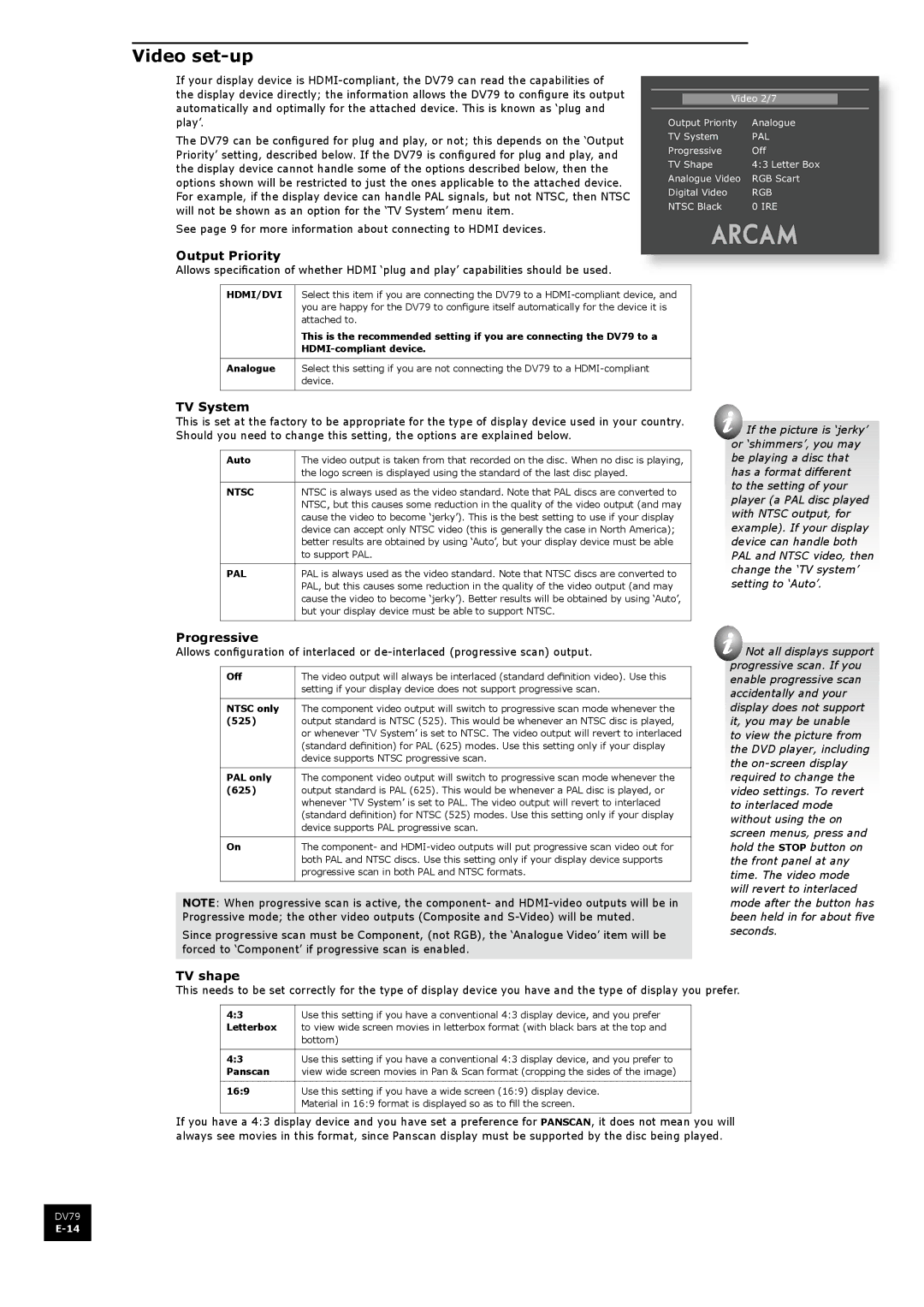
Video set-up
If your display device is
The DV79 can be configured for plug and play, or not; this depends on the ‘Output Priority’ setting, described below. If the DV79 is configured for plug and play, and the display device cannot handle some of the options described below, then the options shown will be restricted to just the ones applicable to the attached device. For example, if the display device can handle PAL signals, but not NTSC, then NTSC will not be shown as an option for the ‘TV System’ menu item.
See page 9 for more information about connecting to HDMI devices.
Output Priority
Allows specification of whether HDMI ‘plug and play’ capabilities should be used.
���������
��������������� ��������
��������� ���
����������� ���
�������� ��������������
�������������� ���������
������������� ���
���������� �����
HDMI/DVI Select this item if you are connecting the DV79 to a
This is the recommended setting if you are connecting the DV79 to a
Analogue Select this setting if you are not connecting the DV79 to a
TV System
This is set at the factory to be appropriate for the type of display device used in your country. Should you need to change this setting, the options are explained below.
Auto | The video output is taken from that recorded on the disc. When no disc is playing, |
| the logo screen is displayed using the standard of the last disc played. |
NTSC | NTSC is always used as the video standard. Note that PAL discs are converted to |
| NTSC, but this causes some reduction in the quality of the video output (and may |
| cause the video to become ‘jerky’). This is the best setting to use if your display |
| device can accept only NTSC video (this is generally the case in North America); |
| better results are obtained by using ‘Auto’, but your display device must be able |
| to support PAL. |
PAL | PAL is always used as the video standard. Note that NTSC discs are converted to |
| PAL, but this causes some reduction in the quality of the video output (and may |
| cause the video to become ‘jerky’). Better results will be obtained by using ‘Auto’, |
| but your display device must be able to support NTSC. |
Progressive
Allows configuration of interlaced or
Off | The video output will always be interlaced (standard definition video). Use this |
| setting if your display device does not support progressive scan. |
NTSC only The component video output will switch to progressive scan mode whenever the
(525)output standard is NTSC (525). This would be whenever an NTSC disc is played, or whenever ‘TV System’ is set to NTSC. The video output will revert to interlaced (standard definition) for PAL (625) modes. Use this setting only if your display device supports NTSC progressive scan.
PAL only The component video output will switch to progressive scan mode whenever the
(625)output standard is PAL (625). This would be whenever a PAL disc is played, or whenever ‘TV System’ is set to PAL. The video output will revert to interlaced (standard definition) for NTSC (525) modes. Use this setting only if your display device supports PAL progressive scan.
On | The component- and |
| both PAL and NTSC discs. Use this setting only if your display device supports |
| progressive scan in both PAL and NTSC formats. |
NOTE: When progressive scan is active, the component- and
Since progressive scan must be Component, (not RGB), the ‘Analogue Video’ item will be forced to ‘Component’ if progressive scan is enabled.
![]() If the picture is ‘jerky’ or ‘shimmers’, you may be playing a disc that has a format different to the setting of your player (a PAL disc played with NTSC output, for example). If your display device can handle both PAL and NTSC video, then change the ‘TV system’ setting to ‘Auto’.
If the picture is ‘jerky’ or ‘shimmers’, you may be playing a disc that has a format different to the setting of your player (a PAL disc played with NTSC output, for example). If your display device can handle both PAL and NTSC video, then change the ‘TV system’ setting to ‘Auto’.
![]() Not all displays support progressive scan. If you enable progressive scan accidentally and your display does not support it, you may be unable
Not all displays support progressive scan. If you enable progressive scan accidentally and your display does not support it, you may be unable
to view the picture from the DVD player, including the
TV shape
This needs to be set correctly for the type of display device you have and the type of display you prefer.
4:3 | Use this setting if you have a conventional 4:3 display device, and you prefer |
Letterbox | to view wide screen movies in letterbox format (with black bars at the top and |
| bottom) |
4:3 | Use this setting if you have a conventional 4:3 display device, and you prefer to |
Panscan | view wide screen movies in Pan & Scan format (cropping the sides of the image) |
16:9 | Use this setting if you have a wide screen (16:9) display device. |
| Material in 16:9 format is displayed so as to fill the screen. |
If you have a 4:3 display device and you have set a preference for PANSCAN, it does not mean you will always see movies in this format, since Panscan display must be supported by the disc being played.
DV79
